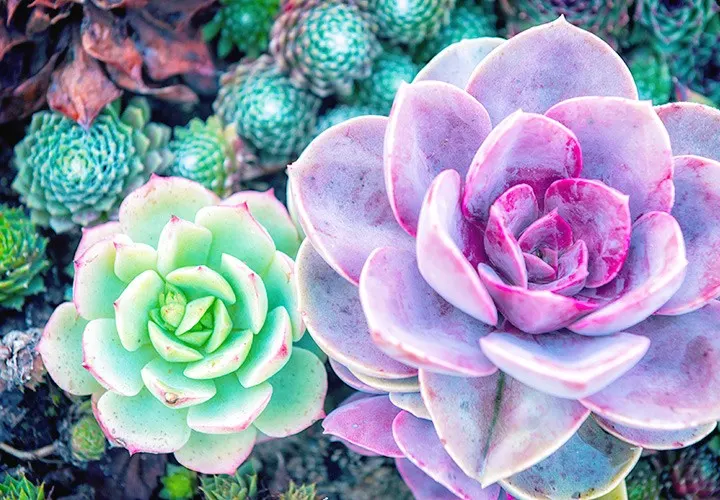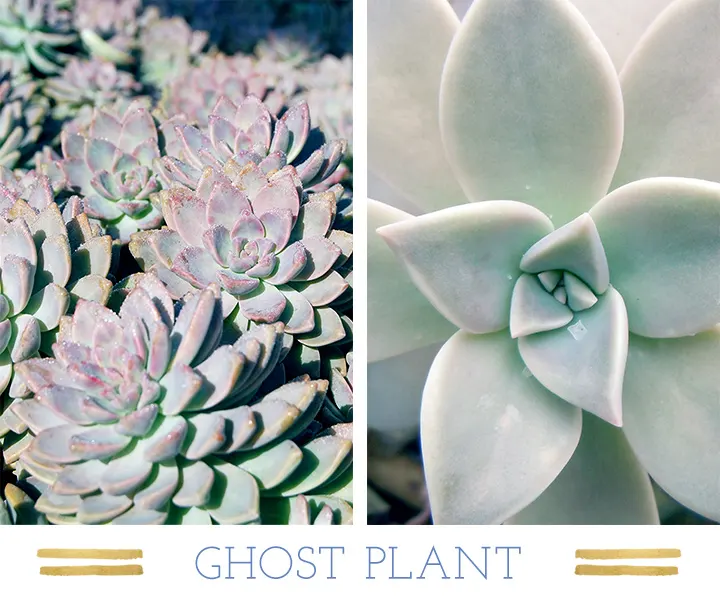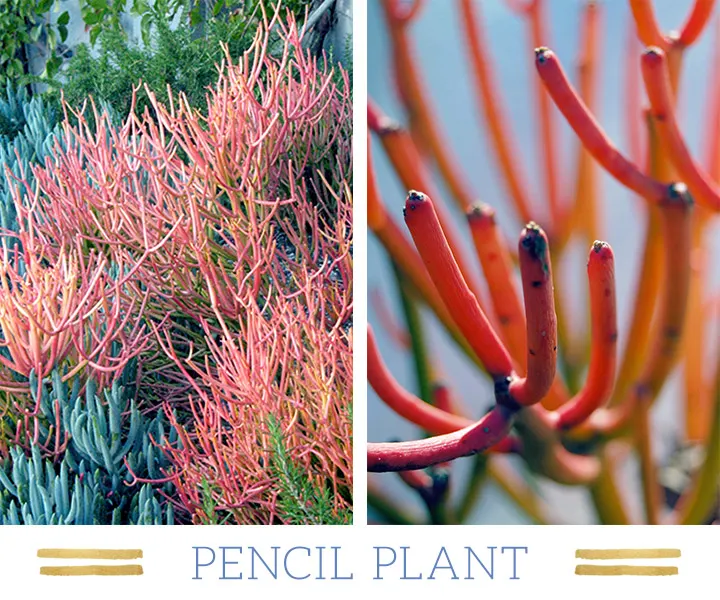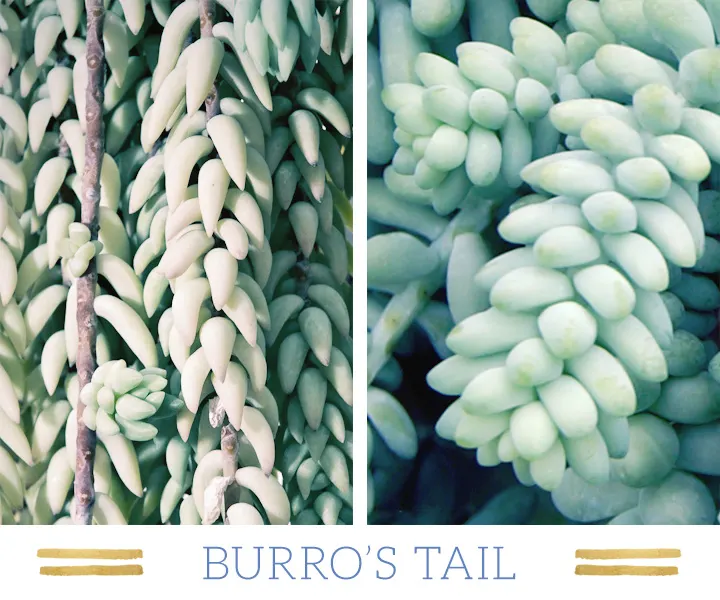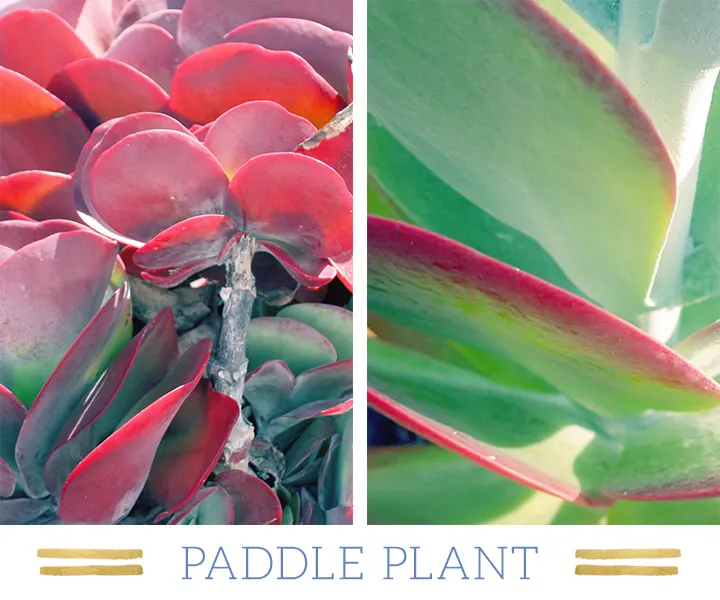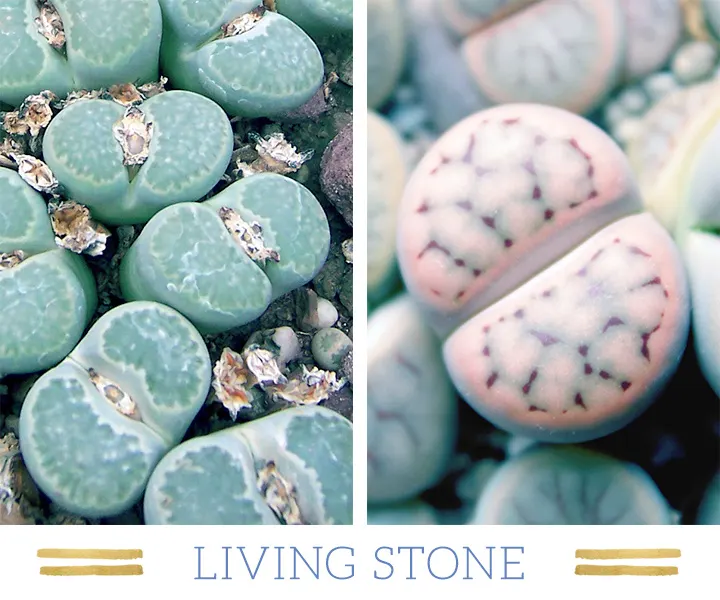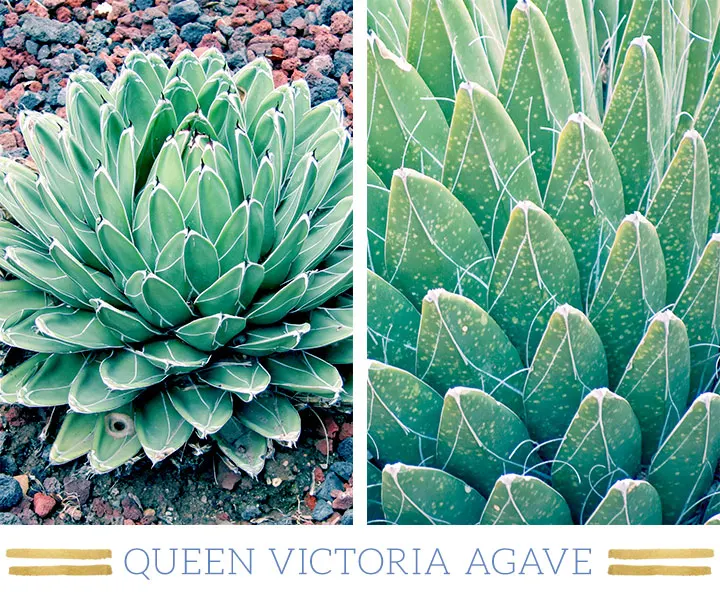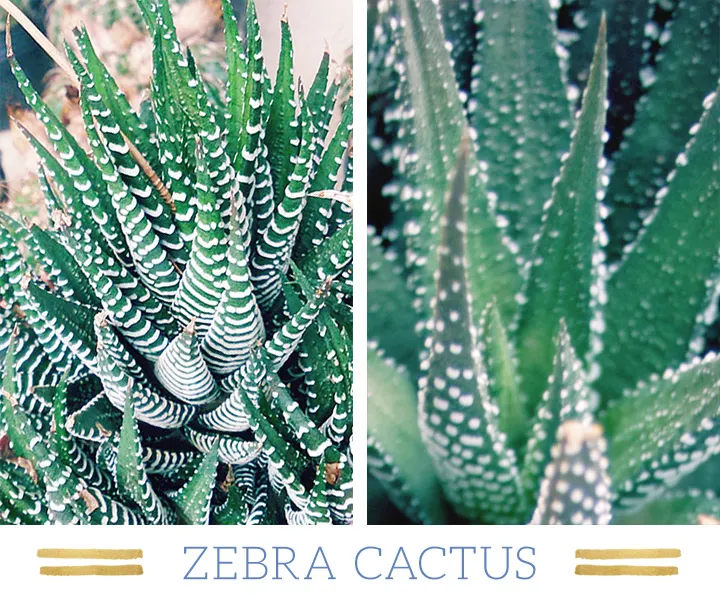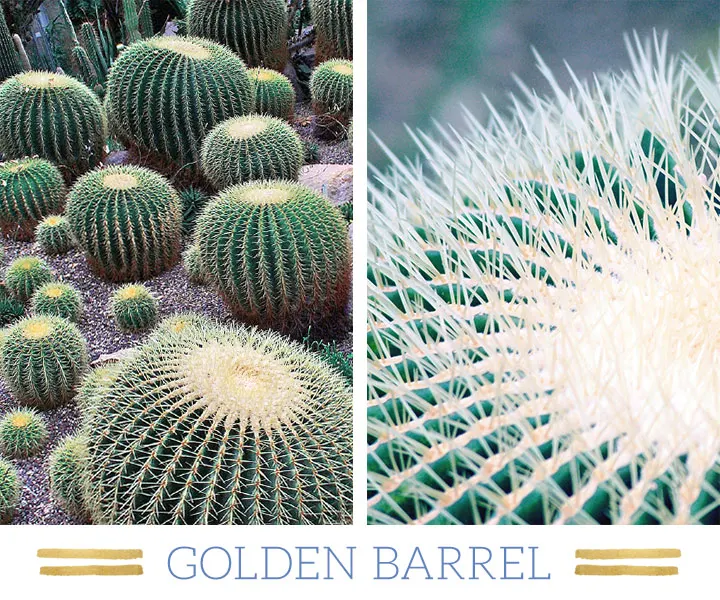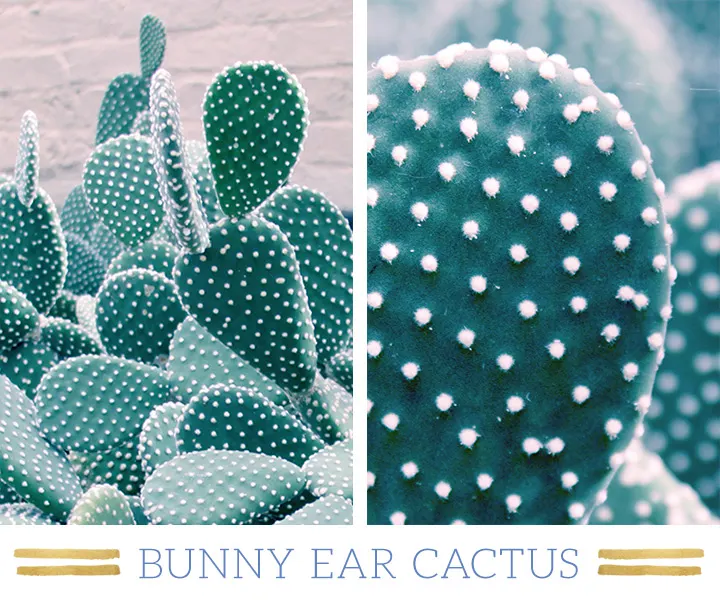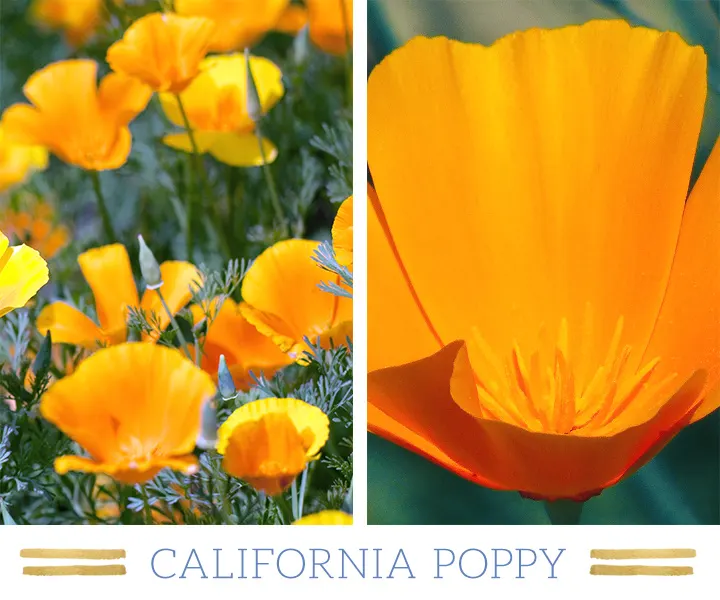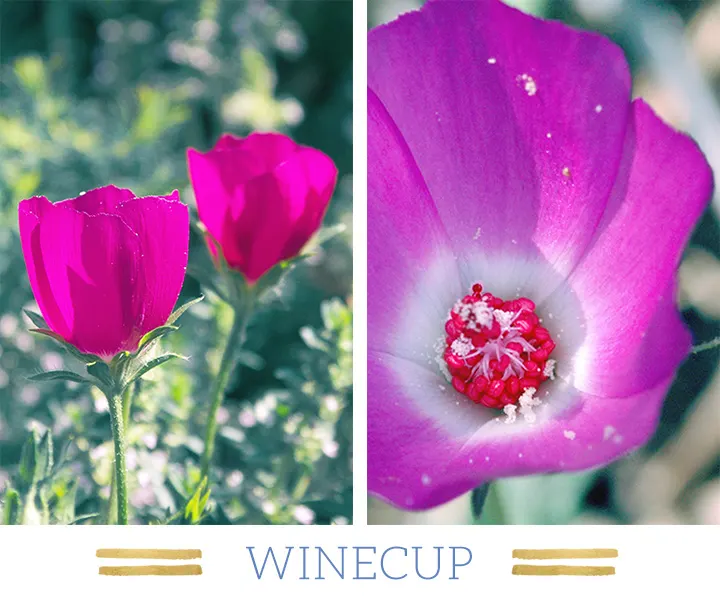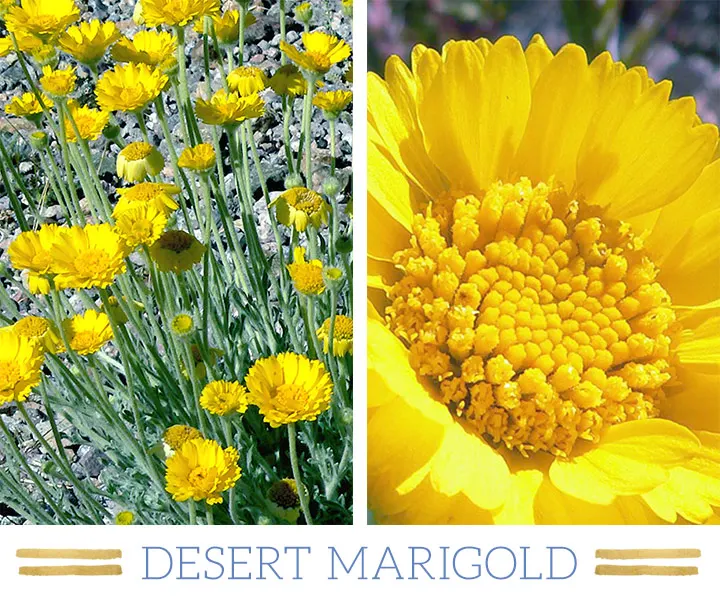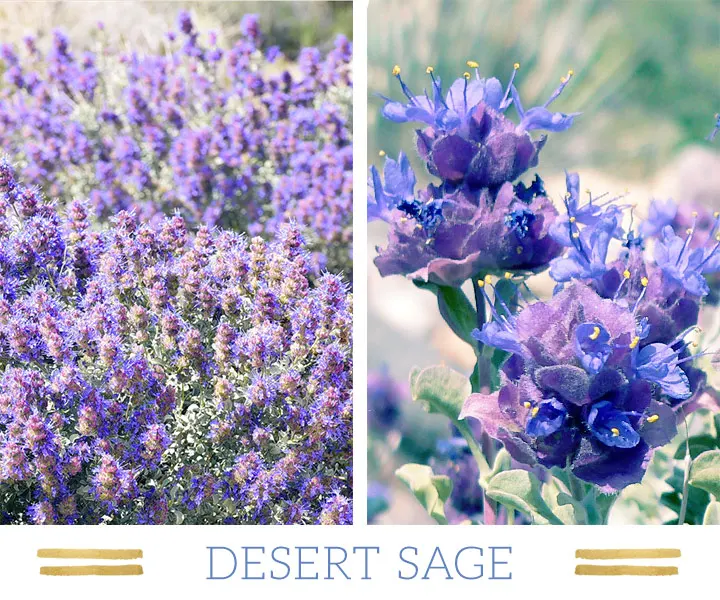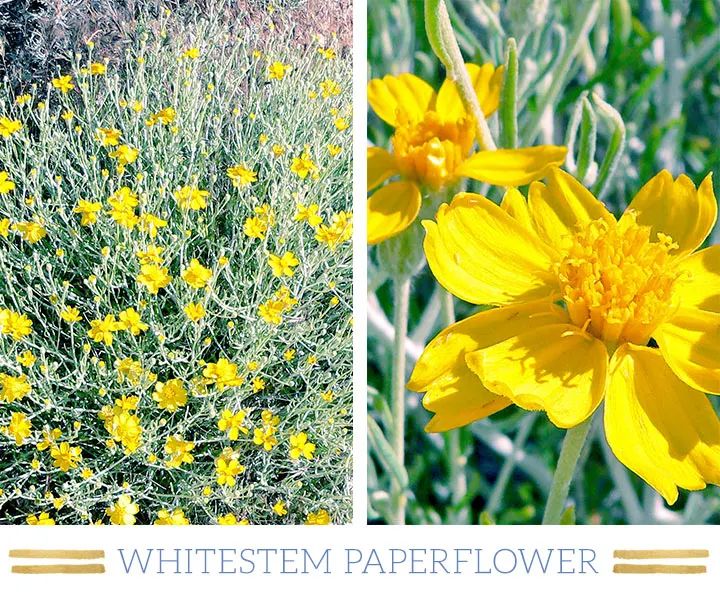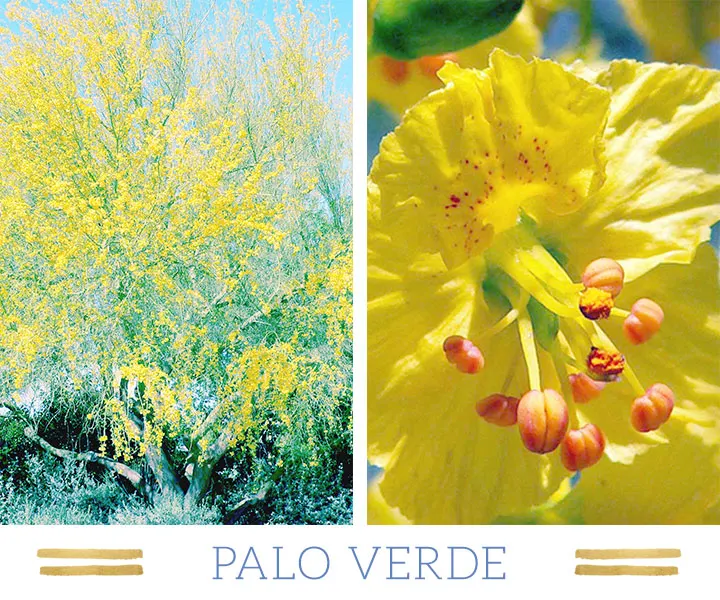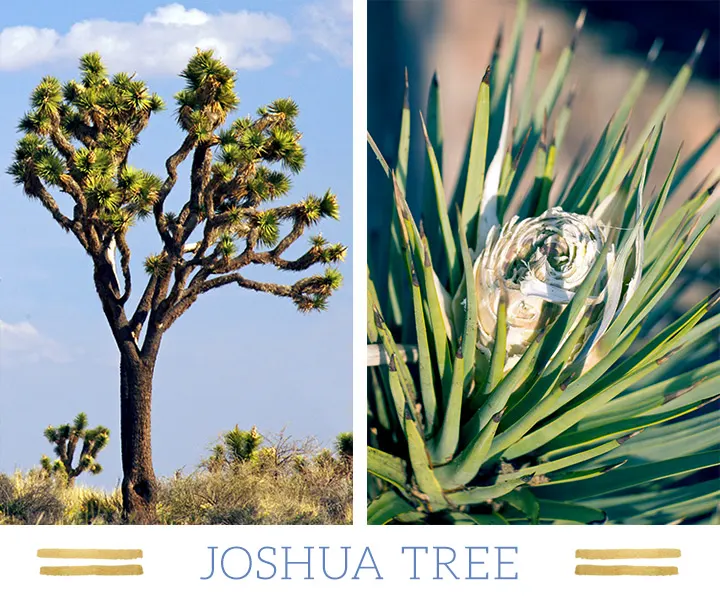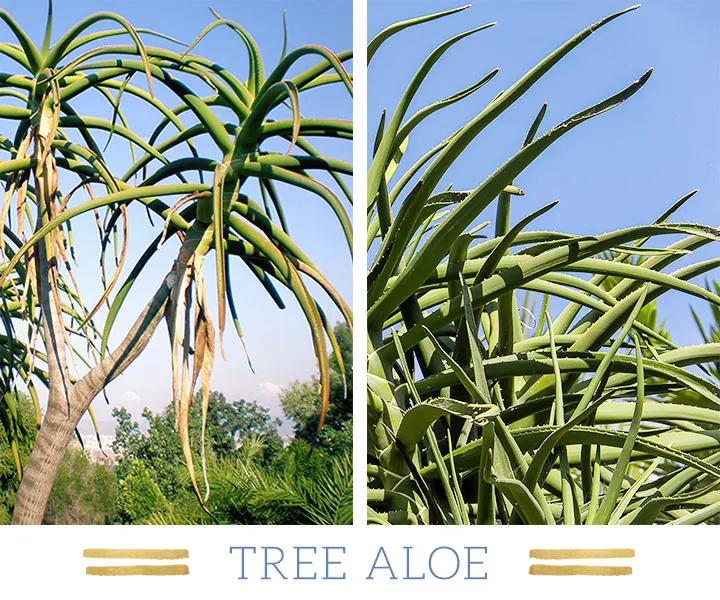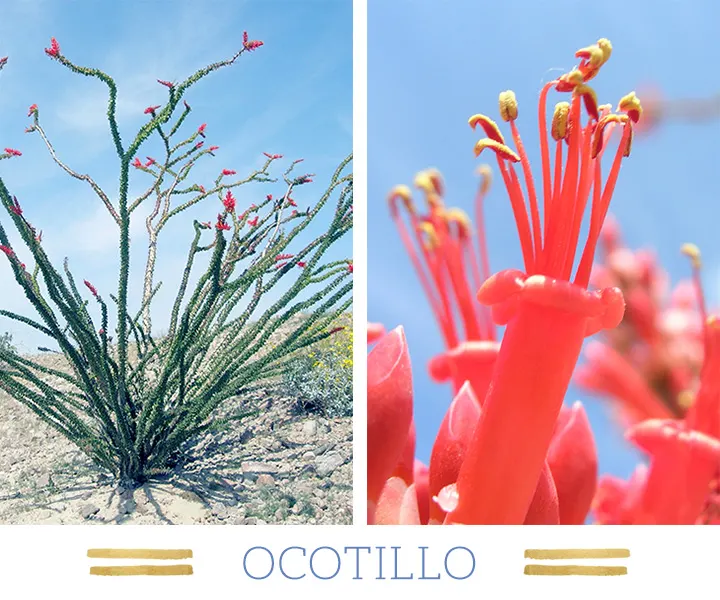June 14, 2016
127 Stunning Desert Plants
Desert plants have found a place in modern home and garden design. There are many plants in the desert that can survive in a xeriscape garden or even in a glass terrarium. The term xeriscape is derived from the Greek word xeros, which means “dry,” and is a form of landscaping that conserves water through the use of native plants. Thus, desert plants have become popular for landscaping because they are easy to take care of due to their drought-tolerant capabilities.
Popular desert plants include the Palo Verde tree, the Queen Victoria agave, the golden poppy, and the Mexican thread grass. To help you identify the many desert plants there are, we created a compendium below of 127 of the most stunning desert plants and succulents.
Desert plants can be classified into three main categories: Cacti and Succulents, Wildflowers, and Trees, Shrubs, and Grasses. For each category, we’ve compiled a helpful desert plants list that outlines the most popular plants within that category.
Succulents
Did you know that all cacti are succulents, but not all succulents are cacti? Desert succulents, including cacti, are the modern gardener’s best friends. Due to their ease of care, and wide variety of shapes, sizes, and colors, the options for designing your home and garden with these trendy plants are endless. From terrariums to your garden, it seems that you can grow succulents almost anywhere.
As long as you provide these drought-tolerant plants with good drainage, sandy soil, and sunshine, they will thrive for years. From the popular ghost plant, to the architectural marvel of the crassula plant, there are so many varieties to choose from. To help you narrow down the many succulents choices that are out there, we’ve picked the top 10 most popular for your home and garden.
Top 10 Most Popular Succulents
1. Ghost Plant
The ghost plant is probably one of the most popular succulent plants used today. Chances are, you’ve seen it in the succulent gardens and indoor terrariums that have become so popular in landscape and home decor. Also known by its scientific name as Graptopetalum paraguayense, it is one of the easiest succulent plants to take care of. Depending on the level of sunlight it receives, these plants can take on various colors ranging from blue-gray to pinkish yellow. When new rosettes form at the tips of its stems, its old leaves fall off. During springtime, you can witness the ghost plant producing bright yellow flowers.
2. Pencil Plant
A popular choice amongst modern landscapers, these succulents are widely used in drought-tolerant landscaping, or xeriscaping. Also known as Euphorbia tirucalli, the plant’s green pencil-like sticks turn bright coral when the plant is under stress. Succulent stress can come in the form of many factors including the plant having too little water, being too cold, or being planted in nutrient-poor soil. Gardeners commonly deprive this succulent, as well as several other types of succulents, of nutrients or water on purpose in order to encourage the plant to display its bright and showy colors.
3. Burro’s Tail
Popular as a house plant, the Burro’s Tail succulent, bears long stems that are plaited with tear-dropped shaped leaves. They are popular for planting in hanging baskets, which allow the long stems to drape to the ground. Colors range from green to blue-green, with an ashy finish that gives the colors a muted tone. Place your Burro’s Tail out of direct sunlight, as the leaves will burn. Partial sun, or brightly-lit shade is best.
4. Paddle Plant
Also known as red pancakes, the paddle plant’s funny nickname is derived from its large, bright red, disk-shaped leaves. They make a striking addition to any xeriscape garden and thrive in hardiness zones 9 to 11. When mature, the paddle plant forms a single flowering stalk from its center. Like many other succulents, the paddle plant is a monocarpic plant, which means that the plant will sprout a flower when it is about to reach the end of its lifecycle. However, there’s good news — to preserve your paddle plant, simply snip off the stalk and replant!
5. Living Stone
Living stones, known as lithops, are a prime example of evolution at its best. These succulents have evolved to seamlessly blend into their surroundings, and protect themselves from predators. Upon first glance, they look just like small stones or pebbles. However, upon closer examination, these stones are actually living plants.
Originating in southern Africa, where they receive less than 2 inches of rainwater a year, these plants are well adapted to dry climates. The extreme climate conditions cause the plant’s formation to be stripped down to just two leaves, which are fused together at its base where the root holds them together. This formation evolved from the plant’s need to have the least amount of surface area exposed to the hot sun. The thick stone-shaped leaves also allow the plant to store as much water as possible. A direct product of evolution, this is truly a fascinating plant to have in your succulent collection!
6. Queen Victoria Agave
The marble-like striations on the petals of this agave make it a favorite amongst modern landscapers. Scientifically known as Agave victoria-reginae, this agave is native to the Chihuahuan desert of Mexico. It is extremely drought-tolerant and thrives in hardiness zone 7. Shaped like a large rosette, it has a very distinguishing look that’s similar to an artichoke. The spherical arrangement of the leaves allows it to funnel water down towards its root base. In the wild, the Queen Victoria agave can live up to 15 years.
7. Zebra Cactus
This incredibly slow-growing plant is often compared to aloe. Its contrasting white striations against its dark green leaves make it a popular houseplant and a trendy way to decorate your home or even office desk. It is easy to maintain, but keep it away from direct sunlight or deep shade. It only needs watering about once a month, and if you’re lucky, the Zebra cactus will flower during the summer if given the proper living conditions throughout the year.
8. Golden Barrel
The Golden Barrel cactus is fittingly named for its large, bulbous shape. Adorned with golden yellow spines, this cactus makes for quite a striking centerpiece in any desert landscape — both in the wild and in your garden! The top of the barrel cactus is where its striking flowers bloom. Once pollinated, it closes up and the seeds begin to develop into fruit, which sits on top of the cactus until pulled out. The Golden Barrel cactus is known for being slow-growing and can live for quite a long time.
9. Bunny Ear Cactus
Believe it or not, the Bunny Ear cactus is actually a type of prickly pear cactus. Upon first glance, it may seem that this cactus does not contain any spines. However, if you look closely, the fuzzy specks that adorn this cactus are actually small clusters of tiny little spines. These types of cactus spines are called glochids, and are nearly impossible to remove if caught in your clothing or skin. Bunny Ear cacti are available in both yellow and white spined varieties.
10. Fox Tail Agave
Also known as Agave attenuata, this agave is commonly found in desert gardens and is a popular choice amongst landscapers. The fox tail agave has a centrally curved spear, from which large green leaves emerge and curve back, resulting in a shape that looks like a large green flower. Its leaves are smooth and pliable, and unlike its other agave cousins, the leaves are completely spineless — making it a safe choice for planting in gardens.
Wildflowers
Desert wildflowers provide a refreshing pop of color in the dry desert landscape. Although they have adapted to survive in such harsh climates, their bloom cycles are extremely sensitive and dependent on a variety of factors including frequency of rainfall during winter, moderate temperatures, wind, and elevation.
Botanists refer to wildflowers as “ephemerals”, meaning that they have extremely short life cycles and will only grow under the right conditions. Once the flowers bloom, they will quickly spread their seeds and a sea of colorful blooms will grow for a short period of time before the plants die. In general, wildflowers are known to start flowering in early spring from February to March.
Although most desert wildflowers are known to be only found in their natural habitat, there are still many species that can be adapted for the domestic garden. Popular garden wildflowers include the California poppy, the desert sage, and the winecup.
Top 5 Most Popular Desert Wildflowers:
1. California Poppy
As the official state flower of California, this poppy is known for its bright orange color. It is native to the western region of the United States, from the coast of Oregon down to Baja California. Due to its popularity and how easy it is to grow, the California poppy can be found in most states in gardens, roadsides, and even empty lots. The petals of this dicot open during the day and close at night. will bloom all summer in California and in cooler coastal climates. In hotter summer regions, the flowers will die after blooming in early spring, and the plant will remain dormant for the remainder of the summer.
2. Winecup
Like the poppy, this drought-tolerant wildflower will open in the morning and close in the evening. The Winecup is a perennial that bears cup-shaped flowers that range in color from light pink to deep magenta. This wildflower will bloom from March to June and thrives in sandy or rocky soil that is well-drained. Outside of the wild, it is popularly used as a bedding plant, or for hanging baskets where its long stems can cascade over the side. One interesting fact about this plant is that it can be medicinally used as a natural pain reliever.
3. Desert Marigold
The name marigold can be derived from its early association with the Virgin Mary, when this golden flower was deemed as “Mary’s Gold.” The desert marigold is native to the southwestern desert areas of the United States. Its long bloom time occurs from March until November, and it can often be seen on roadsides where it covers the landscape in a thick yellow blanket. It is common to see flowering buds sealed into a hard ball. This is the result of the symbiotic relationship between the desert marigold and the desert marigold moth larvae, which envelops the flower into a cocoon.
4. Desert Sage
The desert sage is one of the most beautiful desert wildflowers. With its bold blue and purple flowers and frosty gray foliage, these wildflowers truly stand out in any desert landscape. Desert sage can thrive in high heat, nutrient-poor soil, and require little watering. Because of these factors, the desert sage is not fitting for fertile soil within most garden settings. However, it is the perfect addition to a xeriscape or drought-tolerant desert garden, because it is great for attracting birds and butterflies.
5. Whitestem Paperflower
The whitestem paperflower is named for its delicate flower petals which dry into paper once the flower dies. Belonging to the same family as the daisy, this flower blooms nearly all year long from spring to fall, and thrives in hardiness zones 8-11. Its bright yellow flowers have five petals, and its stems can grow up to 12 inches tall. The whitestem paperflower is native to the southwestern United States and can be found in Southern California, Nevada, Utah, and New Mexico all the way to northern Mexico.
Trees, Shrubs, and Grasses
Beyond cacti, succulents, and wildflowers, the rest of the desert landscape is inhabited by trees, shrubs, and grasses. Like cacti and succulents, this subgroup of desert plants does not require much care and tends to be slow-growing. From the green Palo Verde tree, to the flowering ocotillo shrub, many of these plants are popular choices for desert garden landscapes.
Trees play a very important role in the desert, as they are one of the tallest plant species and provide necessary shade and protection for other desert plants. It is amazing to see how such large trees have evolved to survive in the desert, with some species that can live for over 100 years! Shrubs and grasses are suited to withstand the harsh dry winds of the desert, with some shrubs that can grow into the size of trees. Here we’ve outlined the top 5 most popular desert trees, shrubs, and grasses.
Top 5 Most Popular Trees, Shrubs, and Grasses
1. Palo Verde
This popular desert tree is known for its striking green trunk and bright yellow flowers. The green trunk is due to the presence of chlorophyll. Because there is so much chlorophyll in the trunk, much of the tree’s photosynthesis occurs there. There are two common types of Palo Verde trees, the Blue Palo Verde, which has a blue-green trunk, and the Foothills Palo Verde, which has a yellow-green trunk.
The Palo Verde is the “nurse” plant of the Saguaro cactus, as the two species are often found inhabiting the same areas. In the wild desert, the tree plays a key role in the procreation of new plant life as it provides necessary shade and protection for young Saguaro cacti and other vulnerable desert plants to grow. In a garden setting, the majestic Palo Verde makes for a striking focal point and is a popular choice amongst xeriscape landscapers.
2. Joshua Tree
The Joshua tree is the largest of the yucca species, and is scientifically known as Yucca brevifolia. This tree is so rare that it only grows in the Mojave desert. One reason for its scarcity is that it completely relies on the female pronuba moth for survival. In fact, this symbiotic relationship has caused the moth to evolve specialized organs to help collect and distribute the Joshua tree’s pollen as it travels from tree to tree. The female moth lays its eggs in the Joshua tree’s flowers where the hatched larvae eat the seeds to survive.
This fascinating tree is extremely slow-growing, and only grows about 2-3 inches a year. It can take up to 60 years for a Joshua tree to mature, and it can live up to 150 years.
3. Tree Aloe
The tree aloe is native to Africa, where it is the continent’s largest species of aloe. Its dark green leaves form dense rosettes, with tips that curve and are lined with sharp teeth. Also known as Aloe barberae, the tree blooms in June and July and bears pink flowers. Unlike many common desert trees, the tree aloe is fast-growing. When tree aloe is planted in a garden, it should have ample space and be planted away from nearby buildings.
4. Ocotillo
The ocotillo is a common desert shrub that bears striking red tubular-shaped flowers from its spiny, leaf-covered stem. Its sharply-toothed stem makes this shrub a popular choice as fencing in the garden. This shrub is native to the Sonoran desert where it prefers rocky terrain. Its bloom time occurs from March to June. Also known as Candlewood, the ocotillo can live a long life of 60 years, with studies suggesting that some can live well over 100 years.
5. Mexican Thread Grass
This perennial bears long thread-like leaves that feather at the ends. The leaves sprout from a middle base from which they cascade outward and downward. The Mexican thread grass is a popular choice amongst landscapers not only for its drought-tolerance, but for its tendency to be naturally pest-free. It can be used as a border or as ground cover, and although it does reseed it isn’t aggressive and will not invade the garden.
The Mexican thread grass will sprout new leaves in the spring. In the summer, if deprived too much of water, the grass may enter a dormant stage and continue its growth once temperatures cool down.
A Compendium of 127 Desert Plants and Succulents
With so many desert plants to choose from it can be difficult to identify which ones are the best for your home and garden. To show you the many desert plants that exist, we’ve created a compendium featuring 127 of the most popular desert plants. So the next time you see that adorable succulent or unique cactus, you’ll definitely be able to identify it!
Share this Image On Your Site
Please include attribution to ftd.com with this graphic.
Resources
www.succulentsandmore.com | environment.nationalgeographic.com | www.amwua.org |
www.bhg.com | www.desertusa.com | www.gardeninggonewild.com 1, 2 |
www.learn2grow.com 1, 2 | www.gardeningknowhow.com | www.joyusgarden.com |
www.lithops.info 1, 2 | www.ourhouseplants.com |www.houzz.com 1, 2 | homeguides.sfgate.com |
worldofsucculents.com | www.gardenguides.com 1, 2 | www.fs.fed.us/ | www.wildflower.org|
www.desertusa.com 1, 2, 3 | www.plantzafrica.com | www.public.asu.edu | www.desertharvesters.org |
www.desertmuseum.org | landscaping.about.com | gardening.about.com
| www.smgrowers.com 1, 2 | www.desert-tropicals.com | succulent-plant.com | davesgarden.com 1, 2
| www.hgtv.com | www.americansouthwest.net | cactiguide.com 1, 2, 3
Image Sources
Ghost Plant left CC Image courtesy of FarOutFlora on Flickr; right CC Image courtesy of Patrice78500 on Wikimedia Commons
Pencil Plant left CC Image courtesy of Mike Boucher on Flickr; right CC Image courtesy of Ralph Hockens on Flickr
Burro’s Tail left CC Image courtesy of Andrew Goloida on Flickr; right CC Image courtesy of Pymouss on Wikimedia Commons
Snow White Panda Plant, Paddle Plant left CC Image courtesy of Frank Vincentz on Wikimedia Commons; right CC Image courtesy of Anika Malone on Flickr
Penwiper Plant, Living Stone left CC Image courtesy of Dysmorodrepanis on Wikimedia Commons; right CC Image courtesy of Quinn Dombrowski on Flickr
Aloe polyphylla, Queen Victoria Agave left CC Image courtesy of J Brew on Flickr; right CC Image courtesy of Ken Bosma on Flickr
Crassula ‘Gollum’, Zebra Cactus left CC Image courtesy of Mokkie on Wikimedia Commons; right CC Image courtesy of Popperipopp on Wikimedia Commons
Golden Barrel left CC Image courtesy of H. Zell on Wikimedia Commons; right CC Image courtesy of Rob Young on Flickr
Bunny Ear Cactus, Woolly Senecio CC Images courtesy of Drew Avery on Flickr
Felt Bush, Fox Tail Agave, Jade plant, Topsy Turvy Echeveria, Vertical Leaf Senecio, Weeping Jade CC Images courtesy of Forest and Kim Starr on Flickr
California Poppy left CC Image courtesy of Neko Nomania on Flickr
Winecup left CC Image courtesy of Patrick Standish on Flickr; right CC Image courtesy of Clinton & Charles Robertson on Flickr
Aloe dorotheae, Banana Yucca, Blue Yucca, Candy Cactus, Cape Aloe, Desert Marigold, Desert Spoon, Indigo Bush, Palo Verde, Whitestem Paperflower CC Images courtesy of Stan Shebs on Wikimedia Commons
Desert Sage left CC Image courtesy of tdlucas5000 on Flickr; right CC Images courtesy of Stan Shebs on Wikimedia Commons
Tree Aloe left CC Image courtesy of Consultaplantas on Wikimedia Commons
Desert Mariposa Lily, Ocotillo CC Images courtesy of Joe Decruyenaere on Flickr
Mexican Thread Grass
Cabbage Head Agave CC Image courtesy of Nauticashades on Wikimedia Commons
Twin-Flowered Agave CC Image courtesy of Raffi Kojian on Wikimedia Commons
Aloe aristata, Parry’s Agave CC Images courtesy of Raul654 on Wikimedia Commons
Queen Victoria Agave CC Image courtesy of Cliff on Flickr
Agave titanota CC Image courtesy of Krzysztof Ziarnek, Kenraiz on Wikimedia Commons
Mezcal Ceniza, Miniature Agave CC Images courtesy of Juan Ignacio 1976 on Flickr
Dinner Plate Aeonium, Strawberry Hedgehog CC Images courtesy of James Steakley on Wikimedia Commons
Aeonium canariense CC Image courtesy of Peter Coleman on Wikimedia Commons
Aeonium decorum CC Image courtesy of Winfried Bruenken on Wikimedia Commons
Aeonium leucoblepharum CC Image courtesy of stephen boisvert on Flickr
Echeveria colorata, Echeveria lilacina, Spiny Aloe CC Images courtesy of Jean-Michel Moullec on Flickr
Biznaga Gigante, Devil’s Head, Pincushion Euphorbia, Spanish Bayonet, Tiger Tooth Aloe, Twisted Barrel Cactus CC Images courtesy of Amante Darmanin on Flickr
Aloinopsis orpenii, Giant Claret Cup CC Images courtesy of Michael Wolf on Wikimedia Commons
Airplane Plant, Aloinopsis schooneesii, Aloinopsis serifera, Baseball Plant CC Images courtesy of C T Johansson on Wikimedia Commons
Organ pipe cactus CC Image courtesy of Ken Lund on Flickr
Queen of the Night CC Image courtesy of dafiana on Flickr
Lady of the Night CC Image courtesy of Malcolm Manners on Flickr
Hildmann’s Cereus CC Image courtesy of José Eugenio Gómez Rodríguez on Wikimedia Commons
Peruvian Apple Cactus CC Image courtesy of Huerto del Cura on Wikimedia Commons
Medusa’s Head, Pleated Cereus CC Images courtesy of Leonora (Ellie) Enking on Flickr
Crassula ‘Buddha’s Temple’ CC Image courtesy of Nadiatalent on Wikimedia Commons
Black Prince, Blue Finger CC Images courtesy of Megan Hansen on Flickr
Black Knight, Echeveria harmsii, Graptopetalum pentandrum, Graptopetalum mendozae, Graptopetalum superbum, Haworthia bolusii, String of Bananas, String of Pearls CC Images courtesy of salchuiwt on Flickr
Echeveria Lola CC Image courtesy of Diane Wellman on Flickr
Hen and Chicks CC Image courtesy of brewbooks on Flickr
Echeveria agavoides CC Image courtesy of stephen boisvert on Flickr
Echeveria pulidonis CC Image courtesy of Dianakc on Wikimedia Commons
Fishhook Barrel Cactus, Panda Plant CC Image courtesy of Nova on Wikimedia Commons
Graptopetalum bellum CC Image courtesy of Salicyna on Wikimedia Commons
Haworthia viscosa CC Image courtesy of Jungle Rebel on Flickr
Haworthia coarctata, Lithops bromfieldii CC Image courtesy of Dysmorodrepanis on Wikimedia Commons
Engelmann’s Hedgehog CC Image courtesy of Marshal Hedin on Flickr
Indian Paintbrush, Lace Hedgehog, Scarlet Hedgehog CC Images courtesy of Andrey Zharkikh on Flickr
Arizona Rainbow Cactus CC Image courtesy of Matjaž Wigele on Wikimedia Commons
Mother of Thousands CC Image courtesy of JMK on Wikimedia Commons
Lithops schwantesii CC Image courtesy of Ivan I. Boldyrev on Wikimedia Commons
Lithops gracilidelineata CC Image courtesy of Averater on Wikimedia Commons
Old Lady Cactus CC Image courtesy of Dallas Krentzel on Flickr
Owl’s Eyes CC Image courtesy of Peter A. Mansfeld on Wikimedia Commons
Feather Cactus, Ladyfinger Cactus CC Images courtesy of Petar43 on Wikimedia Commons
Moonstones CC Image courtesy of Col Ford and Natasha de Vere on Flickr
Cape Blanco CC Image courtesy of Rosewoman on Flickr
Blue Ice Plants CC Image courtesy of Jason Baker on Flickr
Canary Island Spurge CC Image courtesy of Akos Kokai on Flickr
Soaptree Yucca CC Image courtesy of cariliv on Flickr
Desert Five-Spot CC Image courtesy of Curtis Clark on Wikimedia Commons
Fairy Duster CC Image courtesy of Melburnian on Wikimedia Commons
Mormon Tea CC Image courtesy of James St. John on Flickr
Pink Muhly Grass CC Image courtesy of Ken Kennedy on Flickr
Bastard Toadflax, Showy Milkweed CC Image courtesy of Matt Lavin on Flickr

